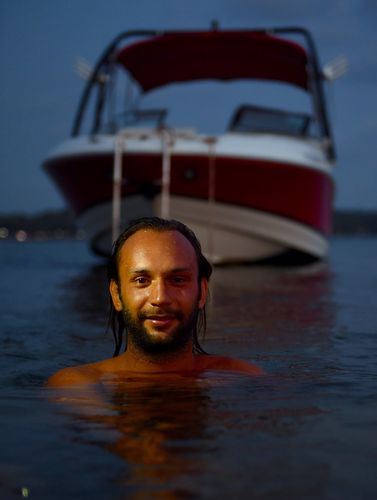Gaurav Arya remembers talking to his bike the first time he rode the old BSA from Delhi to Goa. “We are here together, we made it,” the hotelier and vintage bike restorer said to his bike. Gaurav moved to Assagao in Goa in 2007 after studying music in London. “In those days, in Delhi society, it was definitely a big step,” recalled Gaurav, 36. People assumed that one moved to Goa only to do techno and trance parties. But his father wasn’t among them. “I don’t want to trap your soul, do whatever makes you happy,” he told Gaurav.
Now, Gaurav feels vindicated because many people who said nasty things about the move “either have houses in Goa today or dream to have one. Some are even planning to move here,” he said. Though he shied away from the word ‘trendsetter’, he said he and his friends were “definitely pioneers in doing it, at a time when it was a taboo. Now, it has become trendy in the rest of the country to move to Goa.”
Many people from different walks of life and with different philosophies have made Goa their home in recent years. Also, things have changed for the better in Goa. “The roads, the connectivity, everything is better now,” said Gaurav, who has a boutique hotel, The Tamarind, and Café Cotinga near Anjuna beach.
Rahul Malaney, who comes from an entrepreneurial engineering family in Mumbai, studied philosophy and art in the United States, but moved to Mandrem in Goa with his partner Jill Ferguson to start a water sports centre and café, Vaayu. Anushka Nadia Menon, 32, beauty and fashion photographer, DJ, singer and producer—after living in Muscat, Australia and Delhi—settled down in Siolim because she got “sick of the city life”. Textile designer and weaver Poonam Pandit, also an Army kid and a bit of “a free spirit”, shifted to Siolim from Delhi almost eight years ago after getting an offer from Goa-based fashion designer Wendell Rodricks. The 42-year-old had earlier worked with export companies, but now works on traditional textiles of Goa for her own brand, Kalakar.
Antima Nahar, 39, graphic designer and illustrator from Rajasthan, studied and worked in London and Mumbai. She moved to Siolim two years ago to run her own branding and brand communications company while trying to focus on her health after a bad attack of rheumatoid arthritis. Smita Singh Rathore, cofounder, Magnetic Fields Festival, after studying and living in Milan, Italy, for a while, moved to Assagao from Delhi where she was designing and running restaurants with her ex-husband. The beauty of Goa, said the 39-year-old, brings out the creativity in her because it allows you to zone in and do your work.
 Making waves: Rahul Malaney, from Mumbai, moved to Mandrem to start his own water sports centre and cafe, Vaayu.
Making waves: Rahul Malaney, from Mumbai, moved to Mandrem to start his own water sports centre and cafe, Vaayu.
To Rahul, Goa seemed like the right place because “the ocean is cleaner here, and it has a really nice community” of international people. “If it is windy, we will go kite surfing. If there are waves, then we will go surfing. If there is no wind, no waves, we will go wakeboarding and kayaking. But the idea is to always appreciate whatever Mother Nature provides,” he said.
Anushka is enjoying “being in nature” in Goa, especially considering “Delhi was getting very polluted and [she] was having a hard time breathing.” As somebody already “set up” in the business of beauty and fashion photography for the last 12 years and being quite well-known in the industry, she now travels to Mumbai, Bengaluru and Delhi only for the bigger assignments that pay well, be it photo-shoots or gigs.
Poonam discovered Baburao Babaji Tidwe, who comes from a traditional weaver family, making kashtis (loincloths) and dhotis like the joda pancha. He was the last guy weaving saris, once a flourishing industry in Goa, and was about to shut shop for lack of demand when Poonam suggested they try out something new. Taking the same weave and construction of the joda panchas and kashtis, they now make trendier designs using natural colour, ayurvedic dyes and organic cotton. “I am making scarves currently, and will move on to bigger sized sarongs as well,” she said.
Antima, whose “body just broke down” in Mumbai after her illness, said, “I felt Mumbai just wasn’t the place to heal, not to mention [spending] a lakh on rent and basics, which didn’t make any economic sense.” That prompted her to move to Goa where she now makes the most of video-conferencing and Skype when she isn’t travelling to Delhi and Mumbai for meetings. She also documents her arthritis journey through doodles under her brand, Antz Doodles.
For Smita, Goa’s serenity was experienced in a paddy field one early morning where she “could hear the dewdrops falling from the palm trees.” Within five months of that experience, she moved to Goa with her two kids, aged six and eight, and a nanny, Seema. Smita is not oblivious to reality and knows that she is speaking from a position of privilege. Though it was smooth sailing for her, it wasn’t the same for Seema. “It was a new place for her and much harder for her to make friends.” So Smita asked her to return to Delhi.
Warm, urban, multicultural and traditional are some of the words used to describe Goa. “It is relaxed. People are fun. As long as you respect them and understand that this is their home, they are pretty cool with you and don’t have any issues,” said Rahul.
Smita, who had a few skirmishes initially thanks to the Delhi number plate on her car, said she “is still peeling the layers of living in Goa”. “We are buying up their properties, increasing their rent, gentrifying the place and making it hard for them to live in a place where they have lived forever. But the minute you go in and take yourself a notch down and see things from their perspective they are simple, open and friendly,” she said. She loves the richness and abundance that Goa offers. “It is a prosperous state and you can feel it in a lot of ways,” said Smita. “In Delhi, for instance, it is so important to make money so that you can live in a beautiful place, eat clean food, drink clean water, but for that I have to be away from my home and my kids and employ people to take care of them. It seems like it is all in reverse because food, clean water and fresh air should be something that I should have anyway. And, here it is there! Every house is beautiful, every part is natural and I don’t have to make money to spend on the basics.” She has happily sunk into a village community life that involves trips to the farm and growing her own food.
Though Anushka took some time getting used to the pace of Goa because “everything is super slow, unlike cities where everything is done promptly,” she has adjusted well by slowing her own pace down. “It has worked well! I am enjoying it,” she said, while showing us around her expansive bungalow. “See my house, this is not something that you can have in Delhi or Mumbai.” Antima echoes Anushka’s sentiment. “Coming from crammed spaces and paying so much money, this is like heaven,” she said. That was the reason why she bought her holiday home in Goa even before she moved there.
Also, exercise—be it yoga, pilates, running or swimming—has become a part of their lives, as has catching the sunset. While Gaurav, Anushka, Poonam and Antima have found their permanent base in Goa, for Rahul and Smita, it may well be a stopgap arrangement. “For now, it is definitely Goa. I want to be here for about ten years and then maybe move to the Andaman Islands or Puducherry or Varkala. But none are as rich as Goa in terms of diversity, complexity and the vibration,” said Rahul. “Where will I go next,” mused Smita. “Maybe the mountains. You can only go deeper into nature. I have to go through a place like Goa which allows you a little bit of both.”






